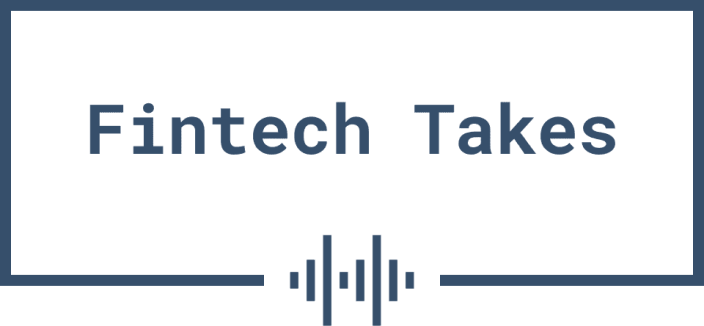
3 Fintech News Stories
#1: Plaid Officially Jumps Into Lending
What happened?
Fintech Takes can exclusively reveal that Plaid has created a separate legal entity, which will operate as a consumer reporting agency (CRA), clearing the way for the company to play a much larger role in helping its customers make lending decisions. According to Mike Saunders, GM of Credit at Plaid:
Today, we’re excited to announce that Plaid has formed a new entity that will build solutions for customers who want ready-made credit risk insights from consumer-permissioned cash flow data.
This new entity will operate as a consumer reporting agency and help our customers make smarter risk decisions throughout the lending process.
So what?
This is simultaneously a big change from the status quo (Plaid has argued, for years, that it should not be considered a CRA) and also not terribly surprising.
As I wrote about last week, everyone in the world of fintech infrastructure seems to be converging on the very obvious idea that lending is profitable, and they should help enable it. Additionally, there was a very real chance (IMHO) that the CFPB would end up applying the Fair Credit Reporting Act (FCRA) to open banking data aggregators anyway, as part of its rulemaking on the FCRA and data brokers.
So, better to get ahead of it! Especially when you consider that, according to Plaid, nearly 50% of its top 100 customers have a credit use case, and, obviously, Plaid has been limited in its ability to help them with those use cases up until now.
What will Plaid’s new credit products look like?
It’s a bit too early to say (Plaid isn’t sharing specific details just yet), but, generally speaking, in the world of credit decisioning, there are four basic steps:
- Collecting raw data – aggregating data that can be predictive of credit default.
- Refining that data into attributes – turning that raw data into useful variables (e.g., number of delinquencies 90+ days).
- Combining those attributes into models – building statistical models to predict credit default, using attributes as building blocks.
- Leveraging those models to make decisions – assembling the attributes and models that you’ve built into a specific sequence of decision rules and processes designed to output credit risk decisions (approve/decline, pricing, etc.) automatically.
Obviously, Plaid was founded to aggregate raw bank account data, so that’s nothing new. However, providing attributes or models for lending use cases required the company to embrace becoming a CRA. Now that it has created one, I imagine that’s the direction it will go. The largest and most sophisticated lenders usually like to build their attributes and models themselves, but most lenders want to get a little help making the raw data more usable. Plaid is very focused on usability. Here’s Mike again:
Plaid has formed this new entity to tackle the usability problem head-on. It enables a future where customers can get actionable and differentiated cash flow insights from open banking transactions data to better predict a borrower’s ability to pay.
It’s important to note that Plaid is not the first company in the open banking space to embrace lending. Finicity has been a CRA for years, and it has been the data aggregation partner that Experian and FICO have used to incorporate cash flow data into their risk models. Ditto for Nova Credit, which started off by creating a cross-border credit bureau (which required it to become a CRA) before adding on a cash flow analytics product for lenders. Edge (a spin-off of subprime lender CreditNinja) recently became a CRA to offer a similar set of data and analytic services to lenders. Prism (a spin-off of Petal) offers a cashflow-based credit score and attributes, although it is not a CRA (think of it as equivalent to FICO in the open banking space).
How will Plaid differentiate itself?
It will surely leverage its established market position to cross-sell lending capabilities to all its existing customers (starting with the 50% of its top 100 customers with lending use cases). I also imagine that it will pitch the breadth of its capabilities as a significant differentiator. If you’re going to integrate consumer-permissioned data access into your application flow anyway, why not also use that data to help with ID verification and streamlining the loan disbursement and repayment processes? Take advantage of the full volcano!
Bank account data also has a lot of utility across the entire lending lifecycle, not just in origination. For example, imagine being able to monitor a credit card customer’s cash flow to detect any early signs of financial distress and using that as a trigger for refreshing their credit limit or initiating pre-collections treatments.
Lots of opportunities!
#2: Worse Than Overdraft
What happened?
Brigit, a company ostensibly focused on helping consumers, has agreed to settle charges from the FTC:
Sign up for Fintech Takes, your one-stop-shop for navigating the fintech universe.
Over 41,000 professionals get free emails every Monday & Thursday with highly-informed, easy-to-read analysis & insights.
No spam. Unsubscribe any time.
The Federal Trade Commission is taking action against personal finance app provider Brigit, alleging that its promises of “instant” cash advances of up to $250 for people living paycheck-to-paycheck were deceptive and that the company locked consumers into a $9.99 monthly membership they couldn’t cancel.
Brigit, also known as Bridge It, Inc., has agreed to settle the FTC’s charges, resulting in a proposed court order that would require the company to pay $18 million in consumer refunds, stop its deceptive marketing promises, and end tactics that prevented customers from cancelling.
So what?
I get that it’s extremely challenging to serve low-income consumers who are living paycheck to paycheck profitably. I understand that the challenge is magnified when you are trying to do so while also building a company that can justify a big investment from venture capitalists (Brigit raised a $35 million Series A led by Lightspeed Venture Partners in 2020).
However, none of that is an excuse for this, and quite frankly, I’m getting tired of seeing this type of shit in fintech.
Perpetually paying $9.99 per month for access to instant $250 cash advances that aren’t instant and that aren’t $250 is substantially worse than any bank overdraft program. Full stop.
Also, it would be nice if the folks at Lightspeed and the other VCs who gave Brigit $35 million could pipe up and explain how this happened or, at least, what they’ll do in the future to try to avoid bankrolling this kind of consumer harm.
#3: Elon Picked the Wrong Goal
What happened?
Elon Musk is committed to his dream of turning Twitter (I refuse to call it X) into a bank:
Elon Musk wants X to be the center of your financial world, handling anything in your life that deals with money. He expects those features to launch by the end of 2024, he told X employees during an all-hands call on Thursday, saying that people will be surprised with “just how powerful it is.”
“When I say payments, I actually mean someone’s entire financial life,” Musk said, according to audio of the meeting obtained by The Verge. “If it involves money. It’ll be on our platform. Money or securities or whatever. So, it’s not just like send $20 to my friend. I’m talking about, like, you won’t need a bank account.”
So what?
I’ve been working my way through the Elon Musk biography, and from what I’ve been able to glean so far, Musk’s two superpowers appear to be:
- Creating a Steve Jobs-like reality distortion field that enables his employees to accomplish seemingly impossible goals. Musk’s primary tactic for this is to implement frequent ‘surges.’ At least two to three times per year, he sets an insane deadline which requires all-hands-on-deck and around-the-clock activity to meet a goal. These surges aren’t necessarily about achieving some mission-critical milestone but rather a way to prevent complacency.
- Picking audacious goals aligned with the broad interests of consumers and governments. For Tesla, the goal is to accelerate the world’s transition to sustainable energy. For SpaceX, the goal is to make humanity a multi-planetary species.
When I look at Musk’s plan for Twitter, I see the first superpower in evidence. He apparently told Twitter employees, “It would blow my mind if we don’t have that [a full suite of banking services] rolled out by the end of next year.”
However, I don’t see the second superpower.
A big reason that SpaceX and Telsa have succeeded is that once they demonstrated that their approaches were viable, it was easy to get consumers and the U.S. government on board. And that support acted as a massive tailwind for both businesses.
I don’t see that same tailwind waiting for Musk when Twitter rolls out its banking capabilities. My guess is that consumers and the government will take a quick look, shrug, and move on. Nobody in the U.S. wants a super app.
2 Fintech Content Recommendations
#1: Brazil (is not) for Beginners (by Isaac Matzner)
My friend Isaac started this podcast, and it’s awesome. Isaac is an American living and building a startup in Brazil. He has taken some time out of his busy schedule to interview other folks with experience doing business in Brazil to illustrate the unique challenges and opportunities that the country presents.
Trust me, you’ll enjoy this one.
#2: Where does neobanking go from here? (by Billie Simmons)
I get a lot of value out of candid retrospectives written by fintech founders whose startups failed. I know they’re hard to write, but they’re really useful.
This one from Billie Simmons, co-founder of Daylight, is worth a read.
1 Question to Ponder
If Fintech Takes published research reports – in-depth, data-driven explorations of specific topics within fintech – what topics would you most want to learn about? And would you be willing to pay for these reports?


